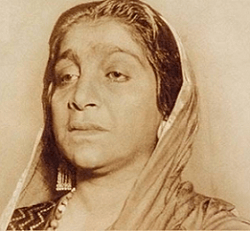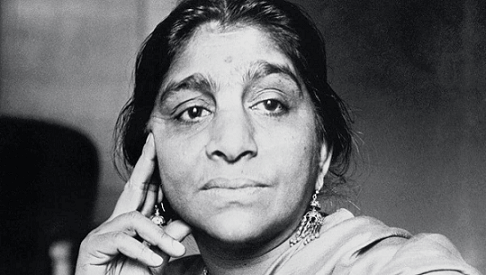Sarojini Naidu
British at that time colonized India and plundered its wealth. Sarojini Naidu, popularly known as the "Nightingale of India, was an Indian political worker, freedom fighter, and renowned poet. She was a dominant image and a role model in making the country free from the shackles of British rule. Inspired by many activists, Sarojini Naidu also played her part to be well recalled today. During her stay in England, she has much attracted to the "Indian national congress" movement, which was operated to make India an independent and self-reliant country. She was assigned the position of the President of the Indian National Congress in the year 1925. Personal life of Sarojini NaiduSarojini Chattopadhyay was born to a Bengali Brahmin family on February 13, 1879. In 1891, at twelve, Sarojini Naidu Chattopadhyay passed her matriculation exam to be eligible for university study, gaining the highest position. She received a scholarship from the Nizam of Hyderabad and attended King's College in London and Girton College in Cambridge in, England from 1895 to 1898. She encountered creatives from the Aesthetic and Decadent movements in England. She toured all over the continent to gain knowledge, experience and witness how life was during the British Raj in Europe. She resided in a house at Brahmangaon Bikrampur in Dhaka. Her father was a Hyderabad college principal, now known as Nizam College. Her mother used to pen down poetry in Bengal. Her family background was well connected to revolutionary and poetic thoughts. One of her brothers was a poet, while the other was a revolutionary. MarriageIn 1898, Chattopadhyay visited Hyderabad once more. Her marriage to Govindaraju Naidu, a doctor she met while living in England, was dubbed "groundbreaking and scandalous" at the time. They were married in the same year. Their union, which lasted a long time and was blissful, had the blessing of both families. Five kids were born to them. Their daughter Padmaja served in several government positions in independent India and joined the Quit India Movement. Inspiring factorsSarojini Naidu was greatly inspired by several activist writers that came and went, leaving a patch of guidance and example for the young generation. Some prominent writers who raised her insights include Rabindranath Tagore and Gopal Krishna Gokhale. She also brought out her inner voice to speak against evil practices that affected the lives of several women across India. Inspired by Mahatma Gandhi's Swaraj movement, she returned to India from England to join Mahatma Gandhi in the Satyagraha movement. She turned out to be a headache for the British due to her shining ambitions and urged women across the country to step their foot out of their homes and contribute to making their country free from the hands of British rulers. Poetry
Sarojini Naidu was highly praised for her memorable works of art in poetry and writing by several other writers. Her collection of Poems was published in 1905, which attracted much recognition from various authors. Her worldwide recognized poetries include ' In the Bazaars of Hyderabad' and 'The Gift of India'. The poem Gift of India communicates the following message: It describes the scene of an Indian soldier's body after death which appears to be heart-wrenching.
Another most popular of her poems include The Bangle seller
Political CareerHer Purposes as an Early OratorNaidu worked as an orator performing her part in raising her voice for women's rights and promoting India's struggle for Independence. She contributed a helping hand in social work for flood relief, resulting in awarding her with Kaisar-i-Hind Medal, but she returned it during the protest over the Jallianwala Bagh massacre, a piteous condition that involved the murder of several innocent people. In 1914, she met Mahatma Gandhi, who credited her and inspired her to boost her actions. She was the second woman appointed the President of the Indian national congress. Her oratory works were well recognized due to their personality and the poetic style followed. Non-Violent ResistanceOne of these marches is well known to us even today. It was a resistance that involved no physical threats towards anyone for claiming Independence or getting the demands of aggrieved parties satisfied or quenched. It involved relying on their struggles, voice, satyagrahas, hunger strikes, and marching on to get the demands fulfilled. 1917 Sarojini Naidu contributed significantly to Mahatma Gandhiji in the Satyagraha movement, including non-violent resistance. In 1920, she also fulfilled a significant role in the non-cooperation movement of Gandhiji when the Britishers refused to reduce the excessive rates of salt in India. It was said that Gandhiji initially did not allow women to participate in Salt March because this movement had a high chance of arrest. But Naidu and other female activists came out of the restraints to play their roles and joined the March. During Quit India Movement, Naidu gave her best and established her role but was imprisoned by the British for two years. She was appointed as the new leader of the campaign after Gandhi's arrest. LegacyNaidu's birthday is recognized as Women's Day in India every year, marking the powerful voices of Indian women in India's history. Gandhiji gave her the title of ' The Nightingale of India.' She is remembered in her first book, ' Golden Threshold.' It is now housed at the University of Hyderabad. Google also celebrated her birth anniversary during the year 2014. Several quotes on her life are available on various websites. Even today, people purchase and read her notorious works and books to remember her works and feel her thoughts at that period. Naidu: An InspirationMany works, including documentaries, autobiographies, and books on Naidu, were published. Her first biography was published in 1966 by Padmini Sengupta. Some of the works on her life were also published by Hachette in 2014. The government of India produced twenty-minute documentaries on her life. In 2020, a biopic on her life was also announced. In this way, she got recognition and left a legacy to reflect on her achievements, social contributions, and other unforgettable works. Her poetry showed the beautiful imagery our Mother India is filled with. She wrote so beautifully that she attracted many appraisals for her writings and continued to write and be selected by several publications for publishing her works with them. Awards and Honors
DeathSarojini Naidu breathed her last on March 2, 1949. She was attacked by a cardiac arrest on the afternoon of March 2, the main reason behind her death. Her health started deteriorating on February 15, and she was suggested to take some rest by the medics. Bloodletting was performed when her situation worsened at the beginning of March. She died, and her last rituals were performed during the funeral. Her death was an unhappy occasion for several Indians. She died two years after the Independence, but her dreams of a free India were achieved and glimpsed by her, which makes every Indian feel proud and say that hard work does pay off. Naidu inspired several women who never spoke up for themselves and worried about the harsh realities of society. She encouraged the women to contribute a significant hand in serving their country, cutting all the boundaries that come as obstacles in their apparent path. Her poems on Indian soldiers and their sacrifices are evidence of her patriotism and undying love for her country. She describes in detail her about free India in her several poems. She was enthusiastic about participating in every movement or activity that supported the interests of India and worked for a complimentary India. With her self-esteem and confidence, she didn't let herself put off her ambitions or halt them. What she did made her worthy of being known today and mentioned in every conversation about freedom fighters. Today, her name is known to every household, child, adult, and personality. Short Summary1st Governor of United Province
President of the Indian National Congress
Personal DetailsBorn
Died
Relative
Children
Alma Mater
Occupation
Literature Journey
Institutions in the name of Sarojini Naidu
Popularly Known
Publications
Political Ideology
Movement and Associations
Some Intriguing Facts About Sarojini Naidu
ConclusionThe phrase "one of India's feminist luminaries" describes Naidu. The day after Naidu's birthday, February 13, is observed as Women's Day to honor the significant contributions made by women to Indian history. A composer, Helen Searles Westbrook (1889-1967), placed Naidu's words to music for her song "Invincible." 1919 Edmund Gosse called her "the most accomplished living poet in India." Naidu is remembered in the Golden Threshold, a University of Hyderabad off-campus annexe named after her debut book of poetry. The Sarojini Naidu School of Arts & Communication at the University of Hyderabad is now at Golden Threshold. Eleanor Helin found asteroids in 1990, and one of them was named after her: 5647 Sarojini Naidu. The Minor Planet Centre (M.P.C. 115893) released the official naming citation on August 27, 2019.
Next TopicShahrukh Khan
|
 For Videos Join Our Youtube Channel: Join Now
For Videos Join Our Youtube Channel: Join Now
Feedback
- Send your Feedback to [email protected]
Help Others, Please Share









